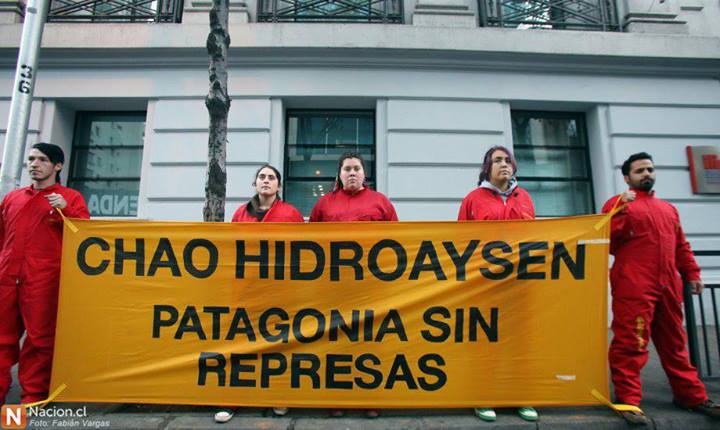
By Daniela Del Bene.
After 8 years of campaigning under the slogan Patagonia Sin Represas, the Bachelet government in Chile rejected yesterday the Hidroaysén project.
The Committee of Ministers, the highest administrative authority of the country (including the Minister of Environment, Health, Economy, Energy and Mining, Agriculture, and Tourism), evaluated 35 appeals filed by the Patagonia Defense Council, which were presented in response to the approval of the project’s Environmental Impact Assessment in May 2011, under the Piñera government. The reasons of the rejections were, among others, the absence of a regular resettlement plan for the affected communities and inhabitants of the region, poor assessment of environmental impacts and insufficient plans for the construction of the transmission lines. But these were only some of the highly problematic aspects of the Hidroaysén project that the campaign raised during these last 8 years.
In 2005 Endesa Chile S.A. announced a huge plan for 2,750 MW of energy generation where five large dams would have been built along the Baker and Pascua rivers in the Aysén Region, in the Chilean Patagonia. The project, controlled by the consortium Hidroaysén (controlled by Enel-Endesa and Colbun), envisaged the flooding of about 6,000 ha of land, in a region of very high biodiversity. If completed, the companies would have owned 80% of the Chilean electricity market and produce power that would have gone mainly for the mining industry in the north of the country.
The opponents to the project, in a joint campaign of Chilean, Canadian, Spanish and Italian movements and organizations for the company being a transnational joint venture, have denounced the unviability of the project, the countless and incommensurable impacts of Hidroaysén and its transmission line, which would have covered 51% of the Chilean territories with towers from 50 to 70 meters high. Such unviability was clear since the very first project proposal, during the previous Bachelet government, when important authorities of the state recommended to reject the project for EIAs being insufficient. Notwithstanding this, the general and majoritarian political conditions were favorable and made the EIAs pass and the project went forward. “Hidroaysén could have never been cleared based on technical or scientific figures. It could only be pushed ahead by political will”, declared Juan Pablo Orrego, international coordinator of the campaign Patagonia Without Dams, during an interview at CNN Chile.
The campaigners also denounced the “terror strategy” used for defending Hidroaysén. In the same interview, René Muga, president of the “Asociación de Generadoras”, warns that the country would need 8 thermal power plants to replace the generation potential of the hydroelectric project, causing maybe more negative impacts in terms of carbon emission and threats to health. However, many of the members of Patagonia Sin Represas want to look beyond the developmentalist idea which sees no other option than producing more and more energy. They call for a systemic change and a comprehensive review of energy politics in Chile, including the Código de Aguas, inherited from the Pinochet era and allowing unacceptable monopolies of private companies over water resources.
“What is still pending now is regulating mining activities (…) as well as the primary industrial phase, extractivism and neocolonialism which have entrapped our country since colonization” declares Orrego. And he remarks: “Chile needs structural changes, which need to include the political, social, environmental and economic sphere”. The campaign Patagonia Sin Represas managed to stop Hidroaysén but knows this is not the only issue at stake. In these 8 years of struggle, the campaign has “hidroaysénised” the debate around the project, encompassing lots of other social and political issues such as education, social welfare, corruption, etc. We just need to remind how the student movements have been inspired by environmental issues and took them into the political debate around what kind of development the country wants and for whose benefit.
However, while Hidroaysén has been scrapped, it’s not very clear how the government will address the energy issue of the country; other hydro project might come up in the region as the Patagonic cordillera is still very attractive. The impacts of the Ralco plant and the plants in Panguipulli are still all there, depressing those areas and bringing repression to local Mapuche communities, while the plant on the Cuervo river is also a matter of concern. Also in the metropolitan region, the hydroelectric project in the Alto Maipo is still ongoing and a large coalition has been mobilizing since 2007. And just the day before Hidroaysén was scrapped, a new thermal power plant in Cabrero has been approved, even without due environmental assessment.
Activists are well aware that the upcoming phase is a up-hill journey and a huge challenge for socio-environmental movements in Chile. The network and the awareness created by Patagonia Sin Represas will surely be a solid basis for it. They can be proud of this epic success for socio-environmental justice and the socio-cultural change it has started.
Patagonia Rios Vivos in Facebook:
https://www.facebook.com/ecosistemaspatagoniariosvivos
Angel Parra sings for Patagonia Without Dams:




viva!